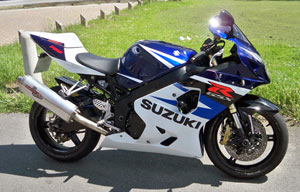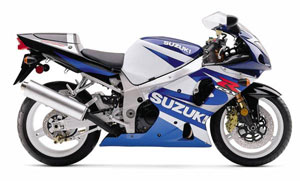Motorbike Reviews
Although the engine had been downsized by approximately 100cc from the GSXR1100, it still delivered a whopping 160bhp at 11,000rpm and the bigger brother to the GSX-R750 was capable of doing a quarter mile within 10 seconds!
If you’re looking for a powerful sports bike, which is fast both on the road and on track, then the GSX-R1000 series is for you. The 2001 model was voted best International Bike of the Year by 13 top bike magazines from around the globe, and lots of my friends swear by this bike as a true power-sports bike.
 The modifications to the styling were influenced by Suzuki’s Hayabusa, with the new positioning of the headlight, and an LED rear tail unit. Other details include a black coloured frame opposed to the silver frame from the
previous years and black powder coated wheels instead of white.
The new shaped gixxer saved weight in a variety of different areas. One of them being the 6 piston brake callipers converted down to a 4 radial piston calliper. This also meant the gixxer saved weight on the discs. Suzuki said not only did it provide better stopping capabilities than the previous design. It also helped to turn into corners, which made for even better track day experiences! The exhaust system was now fully titanium, also contributing for the lighter motorcycle.
The power and torque of the engine were increasing. Not by changing the engine but by delivering a different air intake system. Hence the different positioning of the headlight to accommodate for the ram-air intakes in the front.
The modifications to the styling were influenced by Suzuki’s Hayabusa, with the new positioning of the headlight, and an LED rear tail unit. Other details include a black coloured frame opposed to the silver frame from the
previous years and black powder coated wheels instead of white.
The new shaped gixxer saved weight in a variety of different areas. One of them being the 6 piston brake callipers converted down to a 4 radial piston calliper. This also meant the gixxer saved weight on the discs. Suzuki said not only did it provide better stopping capabilities than the previous design. It also helped to turn into corners, which made for even better track day experiences! The exhaust system was now fully titanium, also contributing for the lighter motorcycle.
The power and torque of the engine were increasing. Not by changing the engine but by delivering a different air intake system. Hence the different positioning of the headlight to accommodate for the ram-air intakes in the front.
 was developed to hold the engine more centrally to help improve the handling of the motorcycle.
Overall the bike was developed to be more air dynamic. Complete with state of the art testing in wind tunnels to create a streamlined machine. The exhaust was made with titanium. To lower the mass of the bike, and help reduce turbulence at high speeds. Also to further reduce the drag on the bike.
was developed to hold the engine more centrally to help improve the handling of the motorcycle.
Overall the bike was developed to be more air dynamic. Complete with state of the art testing in wind tunnels to create a streamlined machine. The exhaust was made with titanium. To lower the mass of the bike, and help reduce turbulence at high speeds. Also to further reduce the drag on the bike.
Suzuki GSXR1000 - All model revamps
Suzuki GSXR1000 K1
In 2001 Suzuki introduced its new sports bike the GSX-R1000 which was to replace the biggest GSX-R model in the series, the GSX-R1100, and took over the mantle from the Yamaha YZFR1 ’98 model, being lighter and more powerful.
Features
The Suzuki GSX-R750 (which won the International Bike of the Year award in 1997) has many features the same, such as the frame, but the material has a slight variation, and the engine is just a redesign of its little brother 750. It has a slightly bigger bore and longer stroke, lighter pistons and a few other minor alterations to give it that perfect performance engine. With the use of titanium in the exhaust pipe and the inside of the front forks, the bike saves on some weight compared to the GSX-R750, and also has an adjustable swing arm to tailor it to the riders requirements just like racing team bikes. The Suzuki GSX-R 1000 K1 comes in standard colours blue/white or black/silver. In 2002 the colours were blue/white or black/red which was one of only a few noticeable changes that the K2 offered. The others being minor alterations which most people couldn’t tell between the two years.Suzuki GSXR1000 K3

Suzuki decided to revamp the GSXR1000 in the later part of 2003, so that the K3 improved on what the GSXR1000 already delivered for your money: light weight, power lightweight handling.
Suzuki GSXR1000 K4
2004 didn’t change much from the K3 apart from a few different colour schemes. Suzuki emblem on the tank changing to just “S” which all the Suzuki motorcycles got branded like that year.Suzuki GSXR1000 K5 / K6

The 2005 K5 had a big revamp, improving the engine and the chassis amongst its biggest changes. The frame was redesigned to be shorter and more lightweight, yet didn’t comprise much on the size of the wheelbase. It


